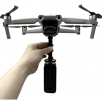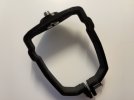Having conquered "dropping items via parachute from my Mavic Air 2," I have had a lot of fun over the last week stringing a few new toys together, and I thought the group might like to hear about it.
The combination of the Mavic Air 2, a 360-degree camera (in my case, an Insta360 One X2), and a bracket to strap those two things together creates some incredibly striking immersive videos when viewed on an Oculus Quest 2 headset.
The bracket, tailor-made for the MA2, is $16.89 on Amazon:
You don't have to hold it with your hand – it will fly on its own.
It's a nice piece of work. It looks like it's 3-D printed, but it's above-average construction. I think I may snap it in half one of these days putting it on or taking it off, but it does not look like it would fail in mid-flight:
The camera hangs from the shaft hanging from that screw on the bottom, but note that there's also a 0.5" screw up top, so you could conceivably bolt two cameras onto your MA2 at a time.
The shaft includes some nifty small white shock absorbers to insulate the camera from the drone's vibrations:
(there's a 0.5" screw you can't see on the bottom of that, to the right...) One thing to note is that the bracket comes totally unassembled, with no instructions, and you have to take your best guess at how its 14+ pieces go together. The photos on the Amazon item page are helpful.
The MA2 flies pretty well with all this hanging from its belly. The bracket weighs 35g and the camera weighs 151g for a total of 186g, much less than the 350g DJI-recommended maximum load, and a tiny fraction of the MA2's 830g real-world maximum lifting capacity.
The camera swings a little, but not too much, and only front and back, and it doesn't look like it's possible for the camera to ever hit a prop. You're not going to want to pull to a sudden stop in Sport Mode, but if you can keep the movements reasonably gradual, you are likely to (b) keep the drone from crashing and (b) keep your audience from throwing up when they watch your movie.
The Insta360's camera is as well-stabilized as the aircraft's. Once you pull the video from the Insta360's camera, you can process it in the phone app, but you lose a lot of resolution and control. You have to run it through Insta360's stitching software to get the full resolution (5.7k, or 5760 x 2880, which sounds more impressive than it is, because those pixels have to cover 360 degrees around three axes).
Here are a few tests:
This is the most finished one I have so far. The drone has been removed from the top of the shot in Final Cut Pro, and pretty music has been added:
The drone is still in the top of the shot in this one, but it has pretty music:
This video is in the process of uploading to YouTube. I haven't surgically removed the drone from the video yet, or modified the sound. Thought you guys might like to see a pretty raw version. All you can hear is the drone, occasionally muffled by the camera's noise cancellation:
These look pretty cool on a phone or computer screen, but on an Oculus, they are totally immersive and stunning. You are there. If you 'subscribe' to these videos on YouTube on your computer or phone, you can pull them up in the YouTubeVR app on the Oculus.
The effect is so stunning that I think DJI will be building 360-degree cameras into its drones sooner rather than later.
Hope this is helpful.
Tom
The combination of the Mavic Air 2, a 360-degree camera (in my case, an Insta360 One X2), and a bracket to strap those two things together creates some incredibly striking immersive videos when viewed on an Oculus Quest 2 headset.
The bracket, tailor-made for the MA2, is $16.89 on Amazon:
You don't have to hold it with your hand – it will fly on its own.
It's a nice piece of work. It looks like it's 3-D printed, but it's above-average construction. I think I may snap it in half one of these days putting it on or taking it off, but it does not look like it would fail in mid-flight:
The camera hangs from the shaft hanging from that screw on the bottom, but note that there's also a 0.5" screw up top, so you could conceivably bolt two cameras onto your MA2 at a time.
The shaft includes some nifty small white shock absorbers to insulate the camera from the drone's vibrations:
(there's a 0.5" screw you can't see on the bottom of that, to the right...) One thing to note is that the bracket comes totally unassembled, with no instructions, and you have to take your best guess at how its 14+ pieces go together. The photos on the Amazon item page are helpful.
The MA2 flies pretty well with all this hanging from its belly. The bracket weighs 35g and the camera weighs 151g for a total of 186g, much less than the 350g DJI-recommended maximum load, and a tiny fraction of the MA2's 830g real-world maximum lifting capacity.
The camera swings a little, but not too much, and only front and back, and it doesn't look like it's possible for the camera to ever hit a prop. You're not going to want to pull to a sudden stop in Sport Mode, but if you can keep the movements reasonably gradual, you are likely to (b) keep the drone from crashing and (b) keep your audience from throwing up when they watch your movie.
The Insta360's camera is as well-stabilized as the aircraft's. Once you pull the video from the Insta360's camera, you can process it in the phone app, but you lose a lot of resolution and control. You have to run it through Insta360's stitching software to get the full resolution (5.7k, or 5760 x 2880, which sounds more impressive than it is, because those pixels have to cover 360 degrees around three axes).
Here are a few tests:
This is the most finished one I have so far. The drone has been removed from the top of the shot in Final Cut Pro, and pretty music has been added:
The drone is still in the top of the shot in this one, but it has pretty music:
This video is in the process of uploading to YouTube. I haven't surgically removed the drone from the video yet, or modified the sound. Thought you guys might like to see a pretty raw version. All you can hear is the drone, occasionally muffled by the camera's noise cancellation:
These look pretty cool on a phone or computer screen, but on an Oculus, they are totally immersive and stunning. You are there. If you 'subscribe' to these videos on YouTube on your computer or phone, you can pull them up in the YouTubeVR app on the Oculus.
The effect is so stunning that I think DJI will be building 360-degree cameras into its drones sooner rather than later.
Hope this is helpful.
Tom














